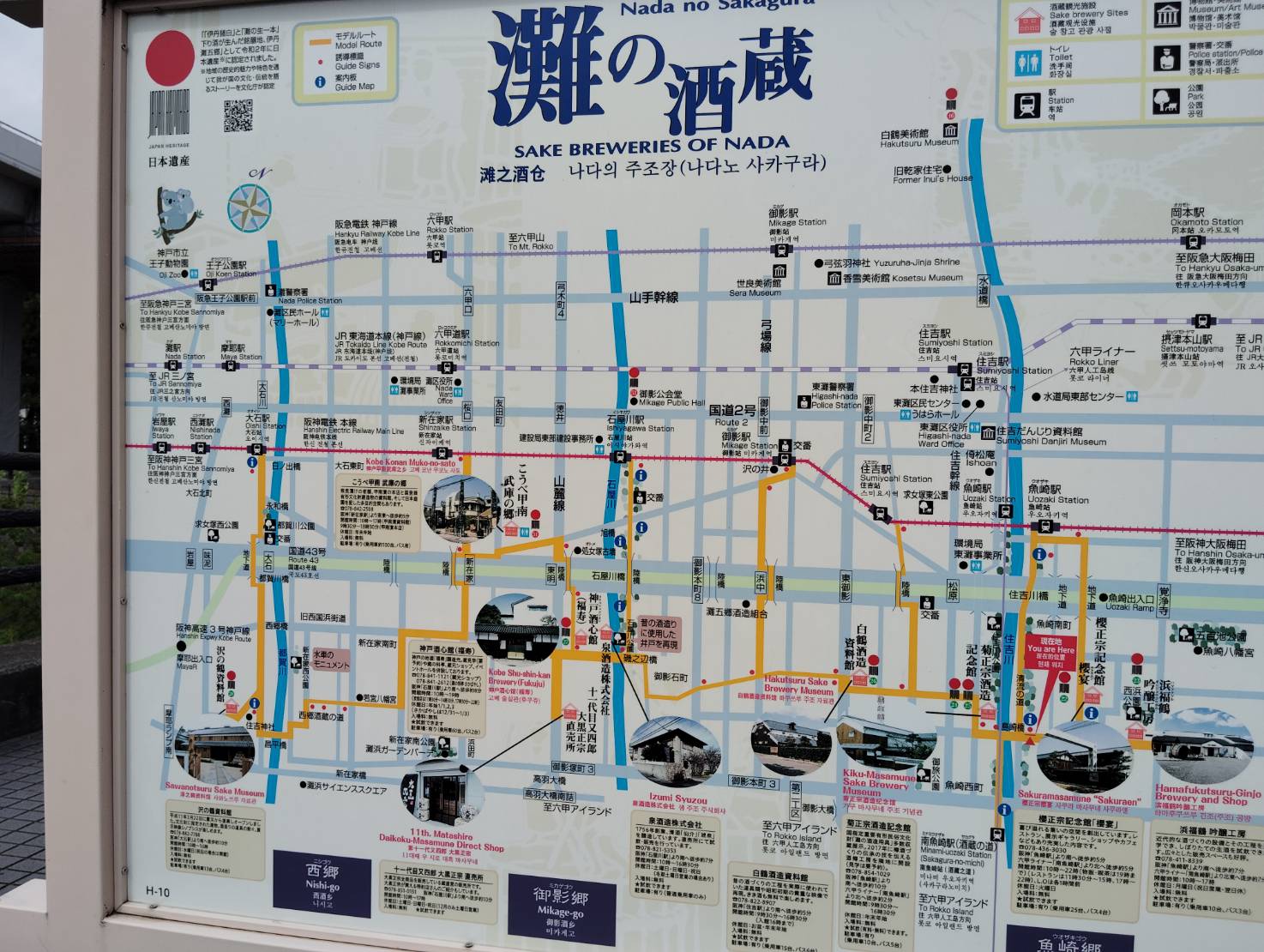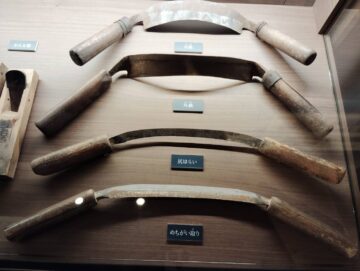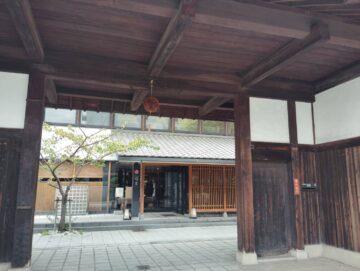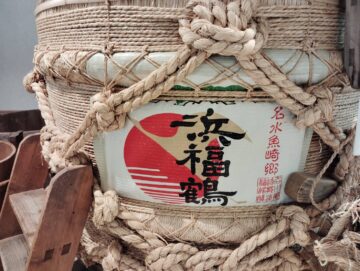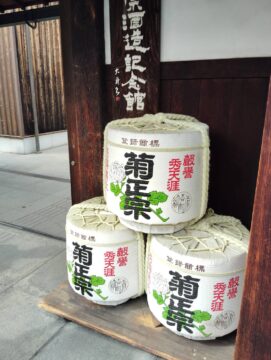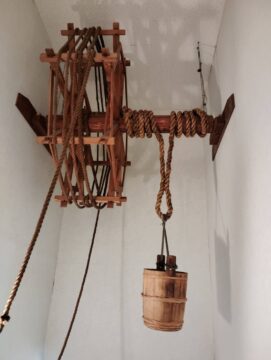【発酵ソムリエ】灘五郷の西側をガイドとまわるツアーを終えて・・・
【発酵ソムリエ】西側の灘五郷・・・一番の収穫は「樽つくり」の知識が増えたこと!
**灘五郷を歩いてみた:魚崎駅から始まる蔵めぐり**
sakuramasamune – 寛永二年創醸~清酒を造り続けて400年~ 宮水の発見・正宗の元祖・高精白の先駆者・協会一号酵母発祥蔵
先日、灘五郷を訪れました。スタート地点は魚崎駅。ここから、西側の酒蔵をガイドと一緒に巡る旅が始まりました。
灘の酒蔵には必ずと言っていいほど北側に窓がたくさんついています。桜正宗。正宗は、日本酒によくつける名前ですが、刀にもつけます。
これは、六甲山から吹き降ろす冷たい風「六甲おろし」を取り込むためだそうです。酒造りに最適なこの風が、昔からこの地の酒を育ててきたのですね。
最初に訪れたのは桜政宗。ここ灘の酒造りに使われる水は「宮水」と呼ばれています。
昔、皇族がこの地に住んでいたことから、その名がついたそうです。
魚崎という地名も「五百の舟が集まる岬(いよさき)」が語源で、隣の御影駅も宮様が水に映る姿を見たことに由来しているとのこと。
地名にも深い歴史が刻まれているんですね。
次に訪れた浜福鶴は、伊丹がルーツの酒蔵。ここでは「空蔵」というラインが印象的でした。
個人的には、伊丹空港かと思いましたが。
この名前の由来は阪神淡路大震災で蔵が倒壊し、空が見えるほどになったことからだそうです。
災害から立ち直り、新たなスタートを切った酒蔵の強さを感じました。
そして、老舗の菊正宗。ここでは、四斗樽の作り方を見学しました。
吉野杉を使い、その香りが日本酒にほのかに移るとのこと。吉野杉は、100年以上前に先代が植えた木を使用しているそうです。
職人さんが「せん」という道具を使い、木の板を削って曲げ、樽を作っていく姿は圧巻でした。
さらに、「たが」を編むところから始め、社員を一から育てる姿勢に菊正宗の伝統と技術の継承の重要性を感じました。
日本の樽は日本酒を漬けた後、味噌、醤油へと使い回されるそうです。
この「縦の流れ」は日本独特で、リベンジを果たすように近年では醤油の樽作りが復活していますという知識は、本日が醤油の日だから思い出したこと。
これに対して洋酒の樽は、ウィスキーからワインへと「横の流れ」で使い回されることが多いとの話も興味深かったです。
また、その樽を船で江戸に運ぶ「くだり酒」という文化も紹介されました。
関西から江戸へと酒が運ばれ、一番乗りすると特権が与えられたため、ゴールが近づくと大騒ぎだったとか。
江戸時代の酒運びは、まさに一大イベントだったんですね。
キクマサギン、キクマサキン、キクマサリッチ、キクマサブルー ブランドサイト|菊正宗 ~灘から世界へ。~ (kikumasamune.co.jp)
最後に訪れたのは白鶴。菊正宗の分家でありながら、現在では最も大規模な酒蔵となっています。
6年前に日本生物工学会での講演会に参加した際、白鶴の工場を見学したことを思い出しました。
白鶴を知る | 白鶴酒造株式会社 (hakutsuru.co.jp)
今回の訪問で、灘五郷の酒造りに込められた歴史や技術、職人たちの情熱に触れることができ、とても感慨深い時間を過ごすことができました。
あなたも一度、灘五郷の酒蔵巡りをしてみませんか?
#灘五郷 #吉野杉樽 #発酵ソムリエ #日本酒 #酒蔵見学
Fermentation Sommelier] Nada Gogo on the west side … the best thing was that I gained more knowledge about ‘barrel making’!
**Walking around Nada Gogo: a tour of breweries starting from Uozaki Station**.
I recently visited Nada Gogo. The starting point was Uozaki Station. From here, we started our journey with a guide to the sake breweries on the western side.
Nada’s sake breweries always have a lot of windows on the north side. Sakura Masamune. Masamune is a name often given to sake, but also to swords.
The reason for this is to let in the cold wind ‘Rokko Oroshi’, which blows down from Mt Rokko. This wind, which is ideal for sake brewing, has nurtured the region’s sake for centuries.
Kobe City: Sake of Kobe (Nada-no-sake) (kobe.lg.jp)
Our first stop was Sakura Masamune. The water used for sake brewing here in Nada is called ‘miyamizu’.
The name comes from the fact that the imperial family used to live here.
The place name Uozaki also derives from ‘Iyosaki’, a cape where 500 boats gather, and the neighbouring Mikage Station is also said to derive from the sight of Miya-sama reflected in the water.
The place names also have a deep history.
The next brewery we visited, Hamafukutsuru, has its roots in Itami. Here, the line ‘Sorakura’ was impressive. Sora means sky.
Personally, I thought it was Itami Airport.
The name comes from the fact that the brewery collapsed during the Great Hanshin-Awaji Earthquake and the sky was so visible.
I felt the strength of the brewery, which has recovered from the disaster and made a new start.
Koyama Honke Sake Brewery丨HAMAFUKUTSURU丨HAMAFUKUTSURU.
And the long-established Kiku-Masamune. Here, we observed how the four-door barrels are made.
They use Yoshino cedar, the aroma of which is subtly transferred to the sake. The Yoshino cedar is made from a tree planted by the previous generation over 100 years ago.
It was a sight to behold as the craftsmen used a tool called a ‘sen’ to shave and bend the wooden planks to make the barrels.
Furthermore, I felt the importance of Kiku-Masamune’s traditions and the passing on of skills in the way they train their employees from the ground up, starting with the weaving of the ‘ga’.
Japanese barrels are used for soaking sake and then used again for miso and soy sauce.
This ‘vertical flow’ is unique to Japan, and the knowledge that the making of soy sauce barrels has been revived in recent years as if to take revenge is something I remembered because today is soy sauce day.
In contrast, it was also interesting to hear that Western wine barrels are often used in a ‘horizontal flow’ from whisky to wine.
He also introduced the culture of ‘kudarizake’, in which these barrels are transported to Edo by boat.
Sake was transported from Kansai to Edo, and as the first to arrive at the goal was given the privilege, there was a great commotion as the goal approached.
Sake carrying in the Edo period was truly a major event.
Kikumasagin, Kikumasakin, Kikumasarich and Kikumasa Blue brand sites|Kikumasamune – From Nada to the world. ~ (kikumasamune.co.jp)
The last brewery visited was Hakutsuru. Although a branch of Kikumasamune, it is now the largest sake brewery.
I recall visiting the Hakutsuru factory six years ago when I attended a lecture at the Japan Society for Biotechnology.
Getting to know Hakutsuru | Hakutsuru Sake Brewery (hakutsuru.co.jp)
During this visit, I was able to experience the history, techniques and passion of the craftspeople behind the brewing of Nada Gogo sake, and had a very emotional time.
Why don’t you try a tour of Nada Gogo’s sake breweries?
#NadaGokyo #Yoshinocedarbarrels #Fermentationsommelier #Sake #Sakebrewerytours


